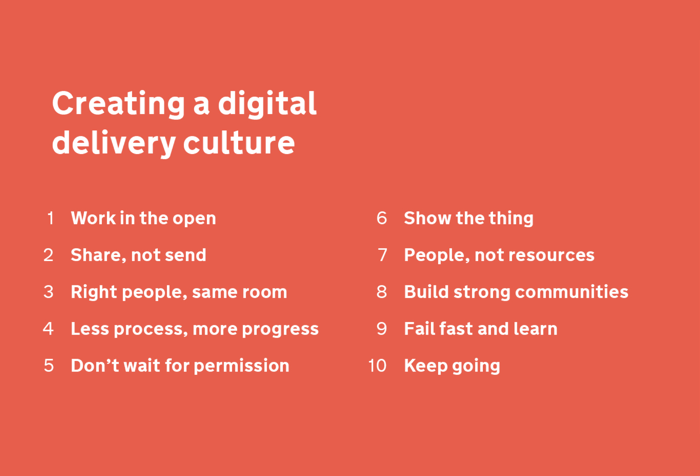Is it transformational?

Last week I spoke at Service Design in Government. I talked about what we need to do to deliver better services. Services that work better for people.
We have lots of conversations in government about transformation.
We all want ‘transformational’. We all agree that transformation is a good idea, but it’s hard to agree what real transformation of government or public services really looks like.
Starting with business transformation
At Digital DWP it’s an important distinction that we’re organising what we do around business transformation, not digital transformation. Our Director General, Kevin Cunnington has set a clear direction for this.
The way I like to explain it is “we’re transforming the business of government.” This means delivering better services for people. Citizens.
Digital isn’t just about websites. If we’re thinking about the business of government a service has to be operational to work well for anyone. It also has to be built on real user needs and policy that happens in the real world.
To deliver a great user experience we need to get the organisation right
At Digital DWP this is happening in different ways. Firstly, the Digital Academy has trained almost 500 people. Colleagues across government are starting to use agile and user-centred design delivery methods.
There’s a business design team looking at the roadmap for where we need to be, and setting the direction for how the department will look by 2020.
Most importantly, we’re thinking about how we work. Both individually and collectively.
Transformation isn’t really about roadmaps, buildings, presentation styles, or the latest technology. To transform anything, I believe that you have to start with the culture of how you do things.
These are some design principles we’ve started to use to talk about the culture of how we need to work.

They’re what I now think of as ‘collective small actions’.
We recognise that we need people to lead by example and this means working in different ways. It’s not easy, but we’re starting to see this happening across government. It means being bold.
The biggest challenge for government is being able to approach problems in new ways. New ways of thinking, and more importantly, new ways of doing.
At the conference I broke down how I think about transformation into 5 key points:
1. Transformation starts small
Everything we talk about when designing user-centred services is built on small actions or moments.
How we work collectively is a series of small but significant actions.
The experiences we’re designing for are a series of small moments or stories. The policy and services that we deliver are about what happens next. What happens in people’s lives.
2. It takes a shift in culture
Culture change happens slowly through these small actions and stories. That’s where I think real change builds momentum.
Momentum is important. The bigger the organisation and cultural shift required, the bigger the momentum you need to create.
I’m convinced that as we see culture change our ways of thinking and doing we’ll start to see real transformation of services.
3. It looks for service patterns
This means building fully functional services, and not projects, products or features.
It definitely means we’re not just digitising the government that exists right now. It understands that there’s no such thing as a ‘tactical digital solution.’
I believe that our ‘service’ thinking needs to start to shift away from the latest government programmes and initiatives.
Instead we need to think about service patterns as a platform and better use of things like registers.
You can read more about government as a platform. The important point is that services should be able to change as policy and circumstances change.
4. It builds momentum through doing
Transformation can start with smaller services. For DWP that’s things like Carers Allowance, Access to Work, and Budgeting Loans.
It starts by delivering improved services, no matter how small, building the momentum that’s needed for real business transformation. It does this alongside operations and policy, no matter the size of the business impact.
Everything we do works together to build momentum towards delivering something better.
There’s a tipping point somewhere between how we build the momentum and then start to build fully transformed services. Operations, policy and delivery. I’m not sure where that is yet. In the meantime, I’m happy to call the greatly improved experiences of people using small services transformational.
We should never say something is not transformational if it helps shape the ways we work while delivering value to real people.
5. It starts and ends with people
Transformation shouldn’t look like a big bang. An explosion.
It might sometimes look like this from the outside. But that mustn’t shape our expectations of what it needs to feel like from the inside.
This is where too many people in government worry that what they’re doing isn’t transformational enough.
The most important point of transformation? It shouldn’t leave anyone behind. It’s important that the people in any organisation can see and feel the buildup of momentum. That includes front-line staff running day-to-day operation of services.
The only way to do this is real delivery and continuous improvement.
Finally, this doesn’t mean new services won’t be cost efficient or generate their own cost savings. The best way to do that is to build services that work well for the people that need them.
Thinking big with small actions
I agree with people like Tom that we haven’t been bold enough in imagining the future of our institutions. That’s real transformation.
But, if I’m not able to do anything else, or get anything else done in government, I’ll take any change we can make to the culture of the Civil Service.
I would start with ‘openness’. Building the trust between colleagues and citizens, which we’ll need as digital and technology shifts more power away from people towards the state.
If automation and better data sharing is the answer then trust and consent needs to be the question.
The challenge
To see transformation in government you have to be able to see it working and that starts with individuals. It’s the result of all the policy, strategy, and delivery.
For me, service design is really about being prepared to ask better questions.
It’s where you choose to look. It’s where you’re choosing to stand right now. It’s how you look at the problem.
I finished my talk last week with a challenge: Are you prepared to get to know someone well enough to see how government really works for them?
If we can get more of government thinking like this, then that’s transformational enough for me. Everything else should follow.
What might eventually look like a sudden big change to those on the outside will have started with small collective actions. How we started to think differently, and then started to work differently.
Never underestimate the impact of what you’re working on right now.
This is my blog where I’ve been writing for 20 years. You can follow all of my posts by subscribing to this RSS feed. You can also find me on Bluesky and LinkedIn.